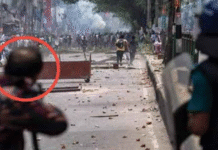
Instead of protecting the Buckland Bund of Old Dhaka, its custodians have been busy erecting illegal structures on the historic dam and its periphery since 1984.
The 1.6-kilometre Bund and its northern side is currently the responsibility of the Dhaka South City Corporation (DSCC), while the southern side, including a portion of the Buriganga river’s foreshore, is a responsibility of Bangladesh Inland Water Transport Authority (BIWTA).
When the dam was handed over to the then Dhaka City Corporation in the 1980s, it almost immediately started building a number of one-storey markets on the northern portion of the dam near Sadarghat and Waizghat.

Though at one point the corporation stopped construction on the dam facing opposition from locals, private businesses continued to commit the misdeed right under the custodian’s nose.
Today, the entire northern side of the Bund, except for the area of the Ahsan Manzil, is occupied by encroachers.
According to historian Muntassir Mamoon’s book titled “Dhaka Smriti Bissmritir Nogori”, Coronation Park, built to mark King George V’s accession to the throne, stretched from Sadarghat to Lalkuthi. A smaller Ladies’ Park was also situated near the dam.
Hashem Sufi, a researcher and a local of Old Dhaka, told The Daily Star that significant rallies were held at the Coronation Park during the British period.
“There was also a fitness centre named Nobojoog Sharircharcha Kendra in the park. The Ladies’ Park was on the western side of the Coronation Park. The latter existed even after the Liberation War.”
The undivided Dhaka City Corporation constructed a market on the Ladies’ Park while individual businesses grabbed the land of the Coronation Park, said Hashem.
At the turn of the century, Dhaka’s mayor Sadek Hossain Khoka demolished the fitness centre and built a multi-storey building in its place.
The current DSCC mayor, Fazle Noor Taposh, could not be reached on his mobile phone after several attempts for comments about the Corporation’s plan on protecting the dam from illegal occupiers and restoring its beauty.
Meanwhile, the south side of the dam, including a portion of the Buriganga’s foreshore, were filled-up by land grabbers, who set up shops and businesses.
Rather the river custodian had built a temporary market on the illegally filled-up riverbank and allocated shops to local businesses.
The temporary market was later demolished, but in 2017, the BIWTA again constructed a number of structures including a four-storey building on the illegally filled river-land.
The filled-up portion of the river from Sadarghat to Shyambazar on the south eastern side of the dam was handed over to the BIWTA in 2016 by the Local Government Engineering Department (LGED), said a BIWTA official.
The source also informed that the LGED is now handing over the south western section of the dam — from Waizghat to Badamtoli — to BIWTA, which is planning to build more structures including a recreational park and a car-parking lot there.
Contacted, BIWTA’s Executive Engineer Motiul Islam said existing laws stipulate that permission must be taken from the BIWTA to construct any structure on the land within 150 feet from the riverbank and no such permission was given to anyone by the BIWTA.
When asked about their plan to build more structures on filled-up river-land, Motiul, also deputy chief director of Dhaka’s circular waterway project, said, “We evict illegal occupiers and they occupy land again. It is a waste of resources. If a permanent structure is built by the government, then land grabbers won’t be able to occupy [the area].”
He did not answer why they are not removing earth from the filled-up portion of the river and its foreshore, instead of building permanent structures.
NO PLACE FOR STROLLS
The historical Buckland Bund was constructed on the bank of the Buriganga river in 1866 by Charles Thomas Buckland, the then commissioner of Dhaka, and was later expanded by elites and merchants including Khwaja Abdul Gani, Ruplal Das and Raghunath Das.
Stretching from Badamtoli to Farasganj, the dam was a place of recreation and entertainment for the city dwellers, who would take afternoon strolls there enjoying the breeze coming across the river.
Several magnificent mansions of the city including Ahsan Manzil, Ruplal House and Lalkuthi were situated along the dam overlooking the river. Except for Ahsan Manzil, none of the other mansions are visible from the river or the dam anymore.
The dam is now one of the most congested and dirty roads in the capital. Endless streams of rickshaws and goods-carrying vans create traffic gridlocks all day long.
Several researchers, historians and environmentalists demanded removal of all illegal structures and recovering the land of the historical Buckland Bund.
Prof Muntassir said the Buckland Bund must be protected for the sake of the Buriganga.
“Saving the Buriganga does not just mean ensuring navigability and cleaning the water. The river’s foreshore must be protected. The dam on the riverbank must be saved,” he said.
Water resource and climate change specialist Prof Ainun Nishat said governments in developed countries construct walkways along riversides, where people take afternoon strolls.
“The Buckland Bund was also constructed for that purpose, not for erecting buildings on it,” he noted.
Researcher Hashem urged the government to restore the dam to its original state and set up benches there for people to spend their leisure along the riverbank.
Abu Sayeed M Ahmed, president of Arcasia, said the removal of illegal structures on the premises of Buckland Bund could offer the city dwellers a place to roam around freely in a clean environment.
“Establishment of government buildings on illegally captured lands do not justify the occupation,” he said.
The government agencies need to set up an example by removing the illegal structures on both sides of the Buckland Bund, he added.
The writer is a freelance reporter and researcher.









